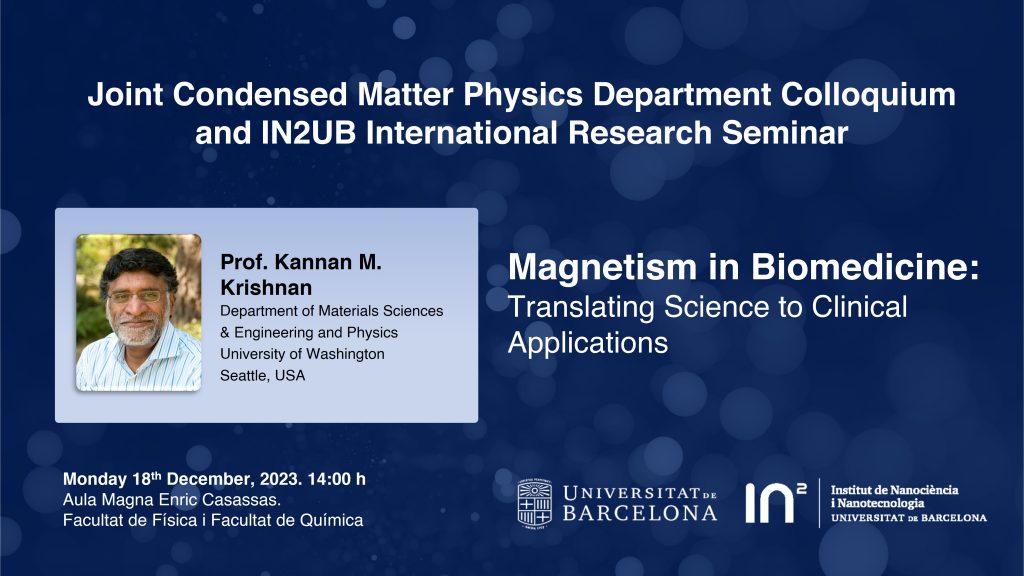Joint Condensed Matter Physics Department Colloquium and IN²UB International Research Seminar
Magnetism in Biomedicine: Translating Science to Clinical Applications
By, Prof. Kannan M. Krishnan, Department of Materials Sciences & Engineering and Physics, University of Washington Seattle, USA
Date and Venue: Monday 18th December, 2023. 14:00 h – Aula Magna Enric Casassas (Facultat de Física i Facultat de Química UB)
(Chaired by Prof. Xavier Batlle, IN²UB and Faculty of Physics)
Abstract:
Recent developments in synthesis[1] and optimization of magnetite nanoparticles. with negligible toxicity and favorable biodistribution [2], allows for reproducible control of their complex magnetic relaxation behavior even in “extreme” biological environments. This has enabled us to address two of the principal challenges in biomedicine [3], i.e. detecting disease at the earliest possible time prior to its ability to cause damage (imaging and diagnostics) and delivering treatment at the right place, at the right time whilst minimizing exposure (targeted therapy with a triggered release). Central to this work is the size-dependent magnetic properties of nanoparticles and specifically tailoring their Néel and Brownian relaxation dynamics in vivo to any specific applied frequency [4]. Such work also requires coordinated efforts in synthesis of highly-monodisperse and phase-pure magnetite cores, biochemical surface functionalization, biodistribution and pharmacokinetic studies, advanced characterization, and stochastic modeling [5] of magnetization response. Currently, our work is focused on Magnetic Particle Imaging (MPI) [6,7], a tracer-based, whole-body imaging technology with high contrast (no tissue background) and nanogram sensitivity [8]. MPI is linearly quantitative with tracer concentration, and has zero tissue depth attenuation [9]; it is also safe and uses no ionizing radiation.
In this talk, I will introduce the underlying physics of MPI, and describe results in the development of highly optimized and functionalized nanoparticle tracers for MPI. I will then present state-of-the-art imaging results of preclinical in vivo MPI experiments of cardiovascular (blood-pool) imaging [10], stroke [11], GI bleeding [12], and cancer [13,14], all using rodent models. If time permits, I will also discuss a related diagnostic method using magnetic relaxation and illustrate its use for detecting specific protease cancer markers in solution [7]. Throughout this talk I will highlight conceptual ideas that help bridge the gap for physical scientists interested in working on translational problems in biomedicine [15].
[1] S. J. Kemp, et al RSC Advances, 6, 77452 (2016).[2] H. Arami, et al, Chem. Soc. Rev. 44, 8576 (2015)
[3] Kannan M. Krishnan, IEEE Trans. Mag. 46, 2523-2558 (2010)
[4] S. A. Shah, et al, Phys. Rev. B92, 094438 (2015)
[5] C. Shasha and Kannan M. Krishnan, Advanced Materials 33, 1904131 (2021)
[6] B. Gleich & J. Weizenecker, Nature 435, 1214 (2005)
[7] S. Gandhi, H. Arami and Kannan M. Krishnan, Nanoletters 16, 3668 (2016)
[8] M. Graeser et al, Scientific Reports, 7, 6872 (2017)
[9] R.M. Ferguson, et al, IEEE Trans. Med. Imag. 34, 1077 (2015)
[10] A. Khandhar et al, Nanoscale 9,1299 (2017)
[11] P. Ludewig et al, ACS Nano 11, 10480 (2017)
[12] E. Y. Yu et al, ACS Nano 11, 12067-12076 (2017)
[13] H. Arami et al, Nanoscale 9, 18723 (2017)
[14] E. Y. Yu et al, Nano Letters 17, 1648 (2017)
[15] This work was supported by NIH grants 1RO1EB013689-01, 1R41EB013520-01, 2R42-EB013520-02A1 and 1R24-MH109085.
About the author:
Kannan M. Krishnan (Ph.D. 1984, UC, Berkeley) is Professor of Materials Sciences & Physics at the University of Washington, Seattle.
Prof. Krishnan has pioneered the field of biomedical nanomagnetics, especially the applications of tailored magnetic biomaterials in medicine, emphasizing imaging, diagnostics, and therapy, and including their commercialization and clinical translations. He was also the first to develop a patented material architecture for semiconductor-magnetic device integration, anticipating the need for such heterostructures for spin-injection in Spintronics, and also identify a new class of materials ––dilute magnetic dielectrics–– that are both ferromagnetic and insulating and showed that the ferromagnetism in such materials is defect-mediated. He is considered a leading expert on elucidating structure-property-processing correlations at relevant lengths scales using electron and photon probes. He is also a highly recognized teacher, writing two comprehensive textbooks, Fundamentals and Applications of Magnetic Materials (2016), and Principles of Materials Characterization and Metrology (2021), both published by Oxford University Press, that are now used worldwide.
Prof. Krishnan is widely recognized in multiple disciplines for his scholarship, research, teaching and mentoring. His awards include the TMS Weertman Educator Award (2024), Alexander von Humboldt Forschungspreis (2016), the TMS Distinguished Engineer/Scientist (2015), IEEE Fink Prize (2012), IEEE Magnetics Society Distinguished Lecturer (2009), Fulbright Specialist (2010), Guggenheim (2004) and Rockefeller (2008) Fellowships, the Burton Medal (MSA,1992), and the College of Engineering Outstanding Educator (UW, 2004). He is an elected member of the Washington State Academy of Sciences, and Fellow of the American Association for the Advancement of Science, the American Physical Society, the Institute of Physics (London), and the Institute of Electrical and Electronics Engineers.

